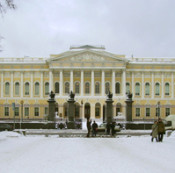
Museums: Russian Museum mounts exhibition “The chosen ones of Clio. Heroes and villains of the Russian History"
On December 8 2010 a large-scale exhibition based on historical subject opened at the Russian Museum (Benois Wing). The exposition called “The chosen ones of Clio. Heroes and villains of the Russian History” spans three centuries of the Russian art and over a thousand of years of the Russian history – from the Varangian Rus’ to modern times.
Paintings, sculptures, photographs, newspaper clippings, and film frames are used to give a more accurate historical portrayal of rulers, generals, rebels, peacemakers and artists. The exhibition has been arranged in the chronological order, however the first exhibit seen by visitors is a monument to the prominent Russian historian Nikolai Karamzin with a statue of Clio - the muse of History.
Early times are represented by portraits of Olga of Kiev, pictures by Nicholas Roerich “Prince Igor Campaign”, Viktor Vasnetsov “The Baptism of Russia”, Mikhail Avilov "A duel between Peresvet and Chelubei in the Kulikovo Field". The whole room is dedicated to one of the most striking and controversial figures of the history of Russia – Ivan the Terrible. Works of different years present myths about him, as a tsar-killer and as a strong personality, a hero. In some pictures he is depicted sitting over the body of killed son, in others – in the Livonian War. Along with paintings there is a screen which shows frames of the Soviet film “Ivan the Terrible” starring Nikolai Cherkasov.
Epochs of the Time of Troubles, Peter the Great, Catherine II, Paul I follow each other in the exhibition. A large section turns the light on the Russian literature of 19th c. Here next to the portraits of representatives of the Golden Age - Pushkin, Lermontov, Dostoevsky – there is a scarlet board with "main Russian questions”: "Who is to blame", "What to do" and "Who lives well in Russia”, which open a “revolutionary” section of the exhibition. It features a lot of portraits of proletariat leaders, as well as portraits of Chapayev and that of Kerensky escaping from Gatchina.
A large section brings into focus heroes of collective farming, udarniks (superproductive workers) of defense and labor, followed by portraits of Secretaries General of the Communist Party of the Soviet Union. The exhibition closes with three photo collages which display the only President of the USSR and Presidents of Russia. The central place of the exposition occupies a screen which shows portraits of historical figures.

